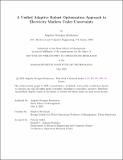A Unified Adaptive Robust Optimization Approach to Electricity Markets Under Uncertainty
Author(s)
Koulouras, Angelos Georgio
DownloadThesis PDF (2.999Mb)
Advisor
Bertsimas, Dimitris
Terms of use
Metadata
Show full item recordAbstract
Electricity grid operations in the US rely heavily on two short-term markets: the DayAhead Market (DAM) and the Real-Time Market (RTM). Although the DAM is the cornerstone of electricity markets, it does not adapt to the fast-changing reality in the grid, such as the increased uncertainties due to renewables. Therefore, the existing deterministic market suffers from inherent uncertainties and creates inefficiencies, which require ad hoc and suboptimal solutions, like out-of-market interventions by the grid operators. To address these issues, in this thesis, we advocate for an adaptive mindset in electricity markets and propose a unified and adaptive redesign of the DAM. The proposed market cooptimizes the existing DAM and out-of-market processes, like the Reliability Unit Commitment (RUC), under adaptive robust optimization (ARO). Through ARO, we explicitly procure and price flexibility using adaptive reserve products that provide generation plans contingent on the uncertainty in the RTM. The grid uncertainty is captured through uncertainty sets that contain all the scenarios against which the market operator hedges, while it is priced through new marginal pricing mechanisms. In Chapter 2, we provide marginal pricing for uncertainty in ARO as a technical enabler of the proposed market. We derive locational marginal prices for unit commitment problems with ARO under load and capacity uncertainty and provide guarantees on the participant incentives under worst-case uncertainty. These pricing mechanisms are then used in Chapter 3, which features the redesign of the DAM. Specifically, the proposed DAM eliminates RUC-like processes by introducing deterministic reserve products that were previously procured in a nontransparent way by the market operators. It also hedges against load forecast errors by using adaptive reserve products that reward participant flexibility. The overall design, which is also applied to ISO New England market data, increases the social welfare and reliability in the market and reduces the arbitrage opportunities. Finally, in Chapter 4, we provide data-driven uncertainty calibration methods for the proposed market. We determine the size of the uncertainty set using machine learning models and mixed-integer optimization, leveraging historical data that consist of covariates or features. This method has been successfully applied to wind generation forecasts from a vendor that caters to a large US grid operator.
Date issued
2025-05Department
Massachusetts Institute of Technology. Operations Research Center; Sloan School of ManagementPublisher
Massachusetts Institute of Technology